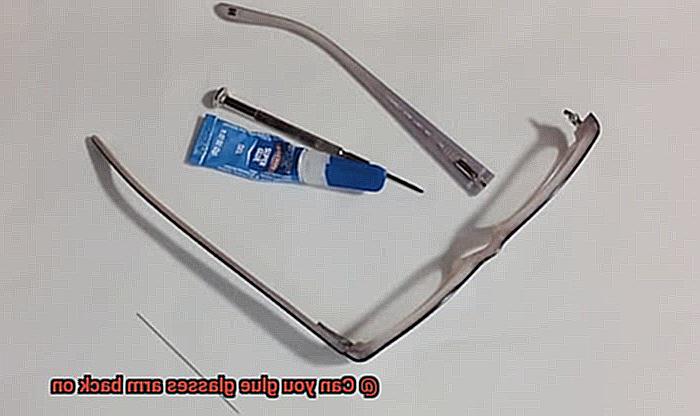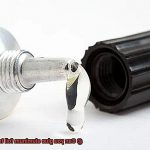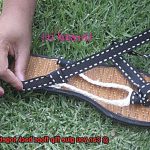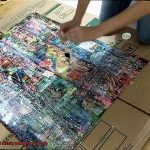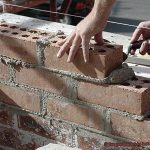We’ve all been there – one moment, you’re going about your day, and the next, your glasses are falling apart. It’s a frustrating situation that can throw off your entire routine. But fear not. There’s a simple and budget-friendly solution to fix this problem: glue. That’s right, with a little DIY magic, you can glue that pesky glasses arm back on and have your favorite eyewear looking good as new.
In this blog post, we’ll guide you through the process step by step, providing all the information you need to know and the materials required. So grab some glue and let’s dive into restoring your beloved glasses to their former glory.
Types of Glue for Gluing Glasses Arm Back On
Contents
- 1 Types of Glue for Gluing Glasses Arm Back On
- 2 Preparing the Frame and Broken Arm for Glue
- 3 Applying Super Glue or Cyanoacrylate Adhesive to the Broken Arm
- 4 Securing the Arm in Place with Clamps or Rubber Bands
- 5 Testing the Repaired Glasses for Stability and Functionality
- 6 Tips for Gluing Glasses Arms Back On
- 7 Long-Term Solutions for Extensive Damage or Recurring Issues
- 8 Common Mistakes to Avoid When Gluing Glasses Arms Back On
- 9 Conclusion
Accidents happen, and one common mishap is breaking your glasses. But fear not. In this article, we will explore the different types of glue that can be used to reattach glasses arms. Whether you need a quick fix or a more durable solution, we’ve got you covered. So grab your spectacles and let’s dive into the world of adhesive options.
Super Glue: The Quick Fixer
When it comes to gluing glasses arms back on, super glue, also known as cyanoacrylate glue, is a popular choice. This adhesive is well-known for its strong bonding properties and quick drying time. With just a tiny drop of this powerful glue, you can work wonders in reattaching your glasses arm. However, it’s essential to use super glue sparingly to avoid leaving behind residue or creating a bulky joint.
Epoxy Resin: The Reliable Bond
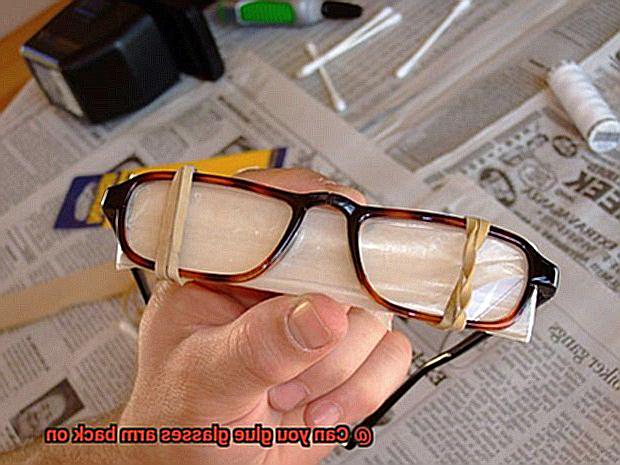
For those seeking a more secure hold, epoxy resin is an excellent option. This two-part adhesive consists of a resin and a hardener, creating a strong and durable bond. Although epoxy resin may take longer to cure compared to super glue, it provides a reliable hold that can withstand stress and repeated use. Before using epoxy resin, it’s crucial to mix the resin and hardener according to the instructions for the perfect blend.
Clear Craft Glue: The Common Choice
If you find yourself without super glue or epoxy resin, clear craft glue or multipurpose adhesive can serve as a temporary solution. These glues are readily available and easy to use, making them a common choice for quick repairs. However, it’s important to note that they may not provide the same level of strength and durability as specialized adhesives. Clear craft glue should be considered only for temporary fixes and not for long-term solutions.
Prep and Precision: Keys to Success
No matter which type of glue you choose, proper preparation is essential for a successful repair. Before applying any adhesive, it’s crucial to clean both the glasses arm and frame surfaces thoroughly. This step removes any dirt or oils that could weaken the bond. Once the surfaces are clean, apply the adhesive sparingly and evenly on both the glasses arm and frame to ensure an even bond. Any excess glue should be wiped away immediately to avoid messiness and interference with the glasses’ functionality.
Temporary Fix or Professional Repair?
While gluing your glasses arm back on can serve as a temporary solution, it’s important to note that it may not always provide a long-lasting fix. If your glasses arms keep breaking or if the damage is extensive, it’s best to seek professional help from an optician or eyeglass repair specialist. They can provide a more permanent solution or guide you in replacing your glasses if necessary.
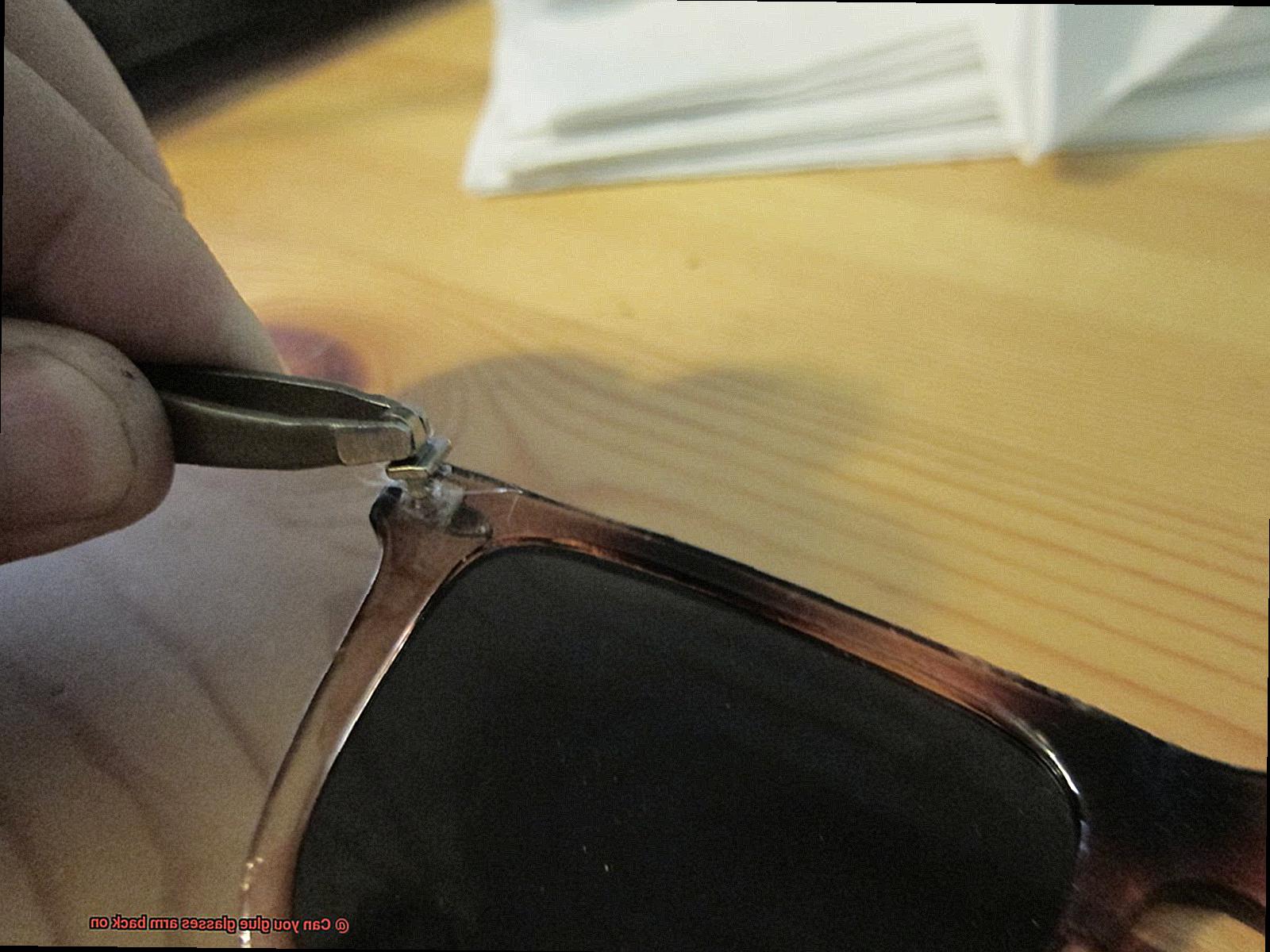
Preparing the Frame and Broken Arm for Glue
When your beloved pair of glasses breaks, it can feel like a heart-dropping moment. But fear not, because we’re here to guide you through the process of preparing your frame and broken arm for glueing, so you can get back to seeing clearly in no time.
First things first, take a good look at the damage. Are there any cracks or fractures? If so, it’s important to mend them before moving forward. You can use a specialized eyeglass adhesive or even a thin layer of clear nail polish to do the trick. This will ensure that the bond is strong and long-lasting.
Once you’ve assessed the damage and made any necessary repairs, it’s time to give your glasses a good cleaning. Use a mild soap or eyeglass cleaner to remove any dirt or oils that might hinder the adhesive’s effectiveness. Be gentle though, we don’t want any scratches. A soft cloth or compressed air can be used to wipe away any residue.
Now comes the fun part – roughening up the surface. Grab some fine-grit sandpaper or an emery board and gently sand both the frame and broken arm. This creates a roughened texture that helps the adhesive stick better. Don’t forget to wipe away any dust or debris afterwards using a clean cloth or compressed air.
Alright, now it’s time to make sure everything lines up perfectly. Hold the frame and broken arm together in their correct position and check for any misalignments. Adjust them until they fit together seamlessly. This will ensure that your glasses sit comfortably on your face once they’re repaired.
Now for the big decision – choosing the right adhesive. There are plenty of options out there, from epoxy resin to super glue specifically designed for glasses repair. Just make sure you pick one that’s suitable for bonding materials like plastic or metal commonly found in eyeglass frames. This will ensure a strong bond that withstands everyday wear and tear.
Once you’ve made your choice, it’s time to apply a small amount of adhesive to both the frame and broken arm. Remember, less is more – using too much glue can create a messy result and potentially damage your lenses. Follow the instructions provided with the adhesive for the best application method and drying time. Patience is key here, as allowing the adhesive enough time to dry will ensure a secure bond.
After applying the glue, carefully join the frame and broken arm together, making sure they align perfectly. Apply gentle pressure for a few minutes to ensure a secure bond forms. And here’s the most important part – be patient. Give the adhesive enough time to dry according to the manufacturer’s instructions.
Applying Super Glue or Cyanoacrylate Adhesive to the Broken Arm
Imagine the heart-stopping moment when your beloved glasses fall to the ground, their arm snapped in two. Desperate for a quick fix, you may be tempted to reach for that trusty tube of super glue. However, before you embark on this hasty repair job, it’s crucial to understand the risks and potential drawbacks associated with applying super glue or cyanoacrylate adhesive to a broken arm. In this article, we will delve into the complexities of this issue, exploring material compatibility, strength and durability concerns, aesthetic consequences, and the benefits of seeking professional help.
Material Compatibility:
Glasses frames are typically crafted from plastic or metal, both of which pose challenges for super glue’s effectiveness. Super glue excels at bonding porous materials like wood or fabric by penetrating their surfaces. However, the smooth texture of glasses frames makes it difficult for the adhesive to adhere correctly, resulting in a weak bond that may not withstand the rigors of daily wear and tear.
Strength and Durability:
Glasses arms endure constant pressure and movement throughout the day. Applying super glue to repair them may yield a bond that lacks the necessary strength to withstand these forces. Picture your glasses arm detaching unexpectedly while you’re wearing them—aside from being incredibly inconvenient, this scenario could also pose injury or damage risks.
Aesthetic Consequences:
Super glue often leaves behind residue or creates visible lines where it has been applied. This unsightly aftermath can detract from the overall appearance of your glasses, turning what was once a stylish accessory into an obvious patchwork of glue. Surely, you want your frames to shine with undetectable elegance rather than sporting a glaring line of adhesive.
Professional Help:

Instead of taking matters into your own hands, it is highly recommended to seek the expertise of professionals when it comes to fixing broken glasses arms. Opticians and eyewear specialists possess the necessary tools and know-how to repair glasses frames effectively. They leverage specialized adhesives or soldering techniques, specifically designed for this purpose, ensuring a reliable and durable fix.
Securing the Arm in Place with Clamps or Rubber Bands
When it comes to fixing a broken glasses arm, there’s a nifty temporary solution that doesn’t involve messy glue – securing the arm in place with clamps or rubber bands. This method provides a quick fix until you can get your glasses repaired professionally. So let’s dive into the details.
First things first, gather your materials. You’ll need small clamps or rubber bands that are strong enough to hold the broken arm in place, without causing any further damage. It’s crucial to choose clamps or rubber bands that are the right size for your glasses frame – we don’t want anything sliding around.
Now comes the delicate part – aligning the broken arm back into its original position on the frame. Take your time and be gentle, ensuring no more damage is done. Make sure the arm fits snugly into the hinge and sits flush against the frame. Perfect.
Now, let’s secure that arm in place. If you have clamps, carefully tighten them around the frame, ensuring they apply equal pressure on both sides of the hinge. But remember, don’t go overboard – we want a secure hold without crushing anything.
If you’re using rubber bands, stretch those bad boys across the frame and loop them around the ends of the broken arm. This ingenious method keeps it snug and secure until you can get it professionally repaired.
It’s important to note that this is just a temporary fix. The clamps or rubber bands might need some readjustment over time, so keep an eye on them. And most importantly, make sure you reach out to an eyewear specialist as soon as possible to get your glasses properly fixed.
So there you have it – a quick and easy way to secure that broken glasses arm without using any glue. Just remember, this is a temporary solution, so make sure you get those glasses to a professional ASAP.
Testing the Repaired Glasses for Stability and Functionality
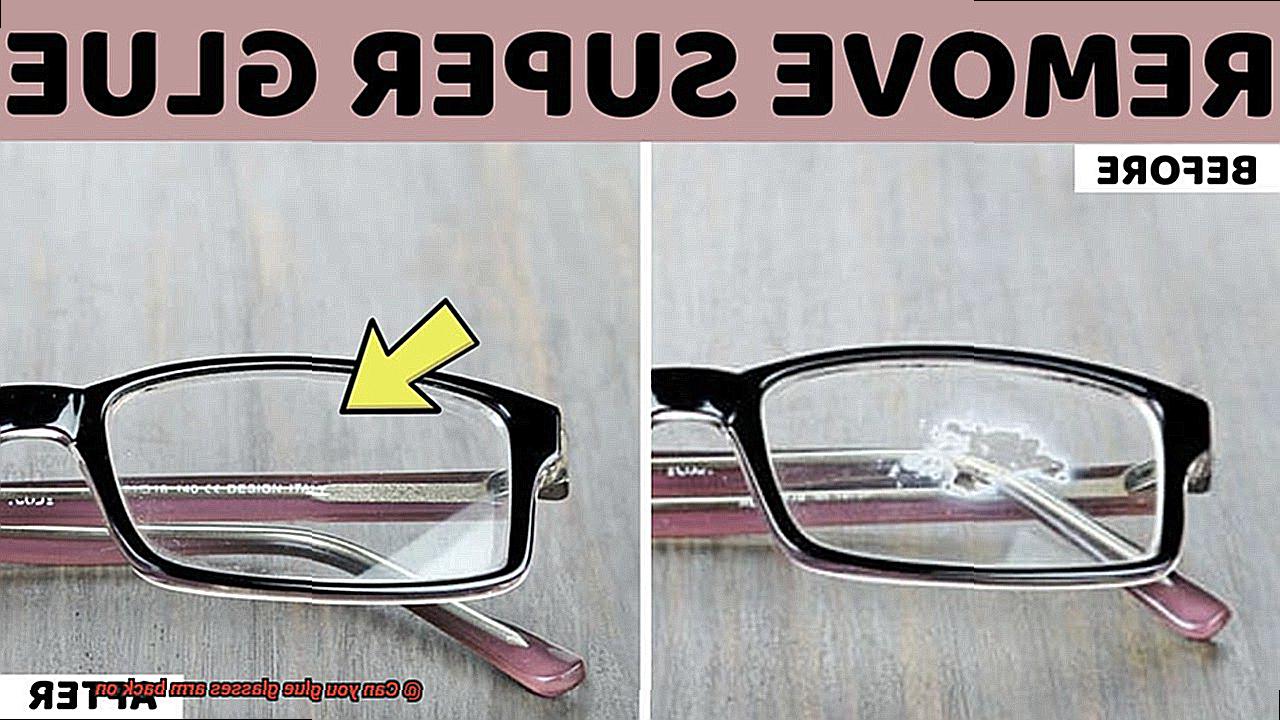
After successfully gluing the arm of your beloved spectacles back together, it’s time to take a moment and test the repaired glasses for stability and functionality. This step is crucial to ensure that your repaired eyewear is secure and ready to be worn with confidence. So, let’s dive into the process of testing these babies and make sure they’re up to snuff.
Stability is the name of the game when it comes to testing your repaired glasses. You don’t want that arm wiggling or feeling loose every time you move your head, right? To check for stability, gently shake your repaired glasses. A firm attachment is what we’re aiming for here. If it wiggles or feels loose, it might need some reinforcement or a different type of adhesive.
But stability is just one piece of the puzzle. Functionality is equally important. Glasses are not just a fashion accessory; they serve an essential purpose – helping you see clearly. To test for functionality, put on your repaired glasses and assess how they feel on your nose and behind your ears. No pressure points or pain should be present. Additionally, make sure the glasses sit straight on your face and don’t tilt to one side. Confidence requires balanced glasses.
Once the fit and stability are in check, it’s time to check clarity. Look through both lenses to ensure clear vision without any distortion or blurriness. After all, what good are repaired glasses if they give you a headache or make you feel like you’re walking on a tilt-a-whirl?
Durability is the final frontier in testing your repaired glasses. Wear them for an extended period, putting them through their paces in normal conditions. Keep an eye out for any signs of weakness or loosening of the repaired arm. You want glasses that can withstand the test of time, right?
If any concerns arise during testing, it’s always wise to consult a professional optician or eyewear specialist. They have the expertise to guide you on further repairs or recommend whether it’s time to say goodbye to your old spectacles.
Remember, regular maintenance and care are essential after the repair. Treat them with love and care, clean them properly, avoid excessive force or bending, and store them in a protective case when not in use. Taking these precautions will help your repaired glasses last longer and minimize the chances of future damage.
Tips for Gluing Glasses Arms Back On
Breaking the arm of your glasses can be a real bummer, but don’t lose hope. Gluing the glasses arm back on can provide a temporary solution until you can see a professional. In this article, we’ll share some tips on how to glue your glasses arm back on and explain why seeking professional repair is crucial if needed.
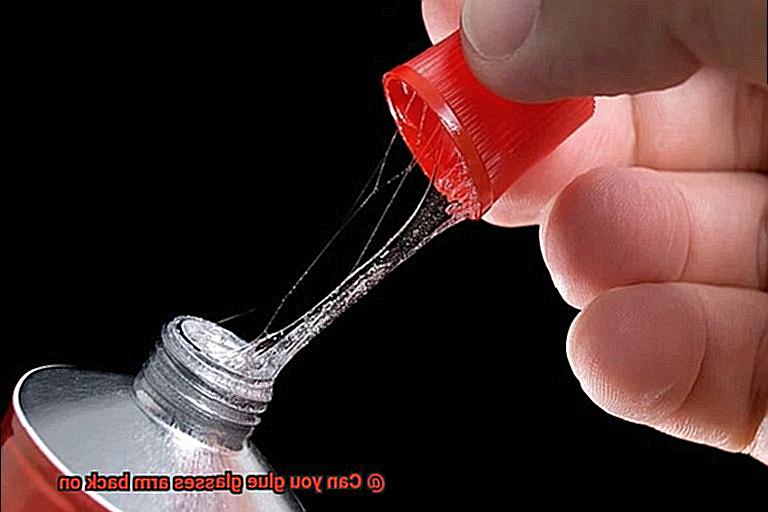
Choosing the Right Adhesive:
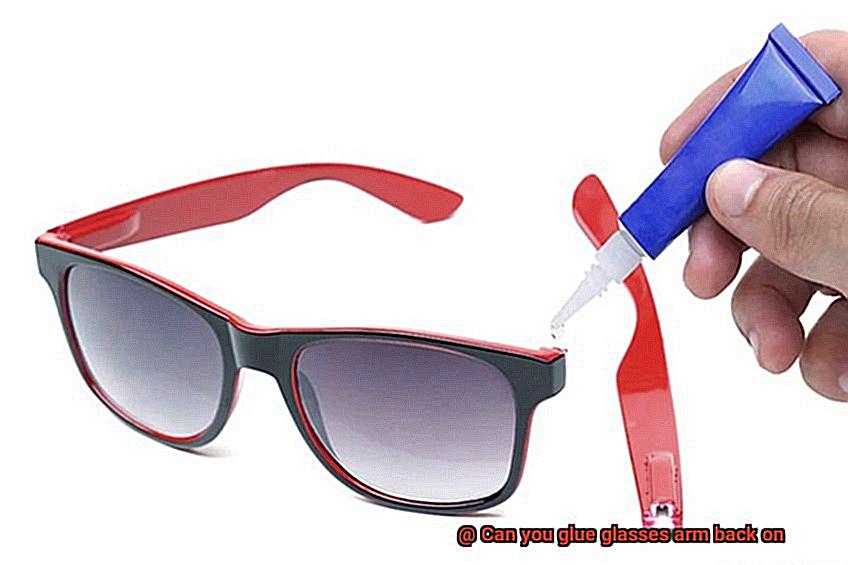
When it comes to gluing glasses arms back on, the adhesive you choose is crucial. Look for a strong adhesive specifically designed for bonding metal or plastic, as most glasses frames are made of these materials. Popular options include epoxy resin or cyanoacrylate-based adhesives, also known as super glue.
Cleaning the Surfaces:
Before applying the adhesive, cleanliness is key. Ensure both the glasses arm and the frame are free from dirt, grease, or residue. Thoroughly clean the surfaces with rubbing alcohol or a gentle soap solution. This will create a stronger bond between the two pieces.
Applying the Adhesive:
Apply a small amount of adhesive to both the glasses arm and the frame. Remember, less is more. Excess glue can make your glasses look messy or interfere with their functionality. Be precise and careful during application to achieve optimal results.
Aligning and Pressing Firmly:
Carefully align the glasses arm with the frame and press them together firmly. Hold them in place for a few minutes to allow the adhesive to set properly. Some adhesives may require additional curing time, so be sure to follow the provided instructions.
Testing and Drying:
After gluing the glasses arm back on, let them dry and set overnight before wearing them again. This ensures a strong and secure bond. Once dry, gently test the strength of the bond by lightly pulling on the arm. If it feels secure, you can confidently wear your glasses again.
Seeking Professional Repair:
While gluing glasses arms back on can be a handy temporary fix, it’s important to note that it may not provide a long-lasting solution. If your glasses arm keeps coming off or if the damage is extensive, seeking professional repair or replacement options from an optician or eyewear specialist is recommended.
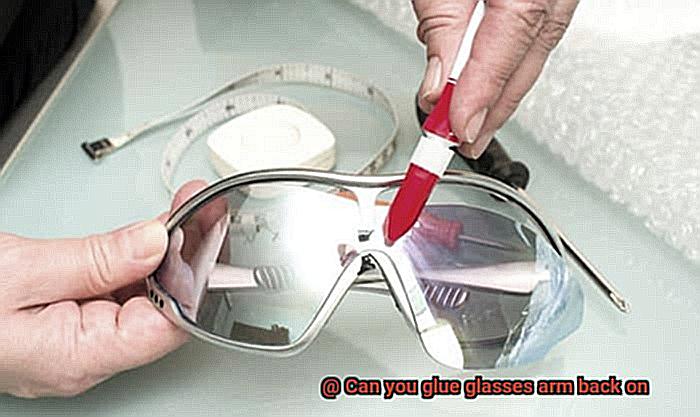
Long-Term Solutions for Extensive Damage or Recurring Issues
Breaking the arm of your glasses can be exasperating, but fret not. While a quick glue fix might work for minor breaks, it’s crucial to explore long-term solutions for more extensive damage or recurring issues. As an eyewear expert, I’m here to share insights and recommendations that will guarantee the durability of your glasses.
Professional Repair or Replacement:
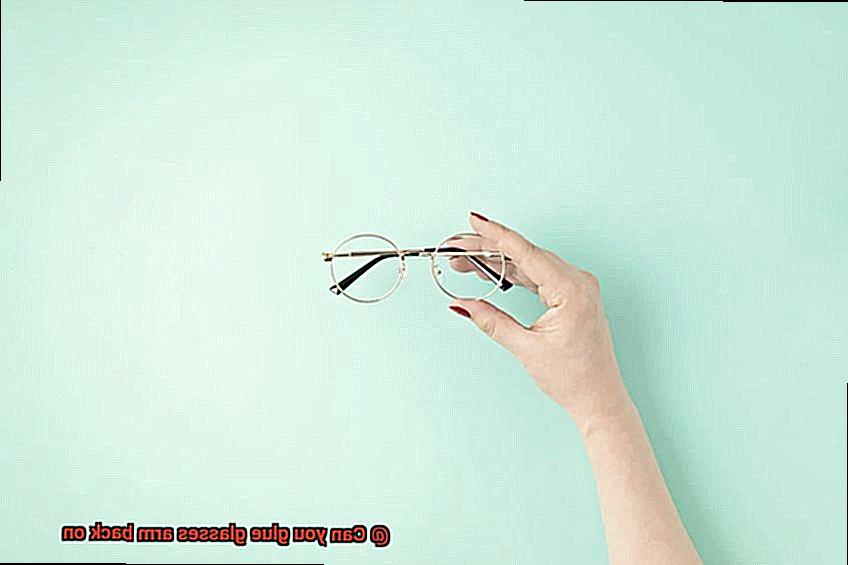
For severe damage, it’s best to entrust your glasses arm to professional repair or replacement. Opticians and eyewear specialists possess the expertise and tools to accurately assess the damage. They employ specialized techniques to either repair the arm or replace it with a matching design.
Sturdier Frames:
Investing in glasses frames made from durable materials like titanium or stainless steel is a wise move. These frames offer both strength and flexibility, reducing the likelihood of breaks or arm bending. Seek frames known for their sturdiness and longevity.
Explore Alternative Eyewear Options:
If you frequently face broken or loose glasses arms, consider exploring alternative eyewear options. Switching to rimless or semi-rimless frames provides different mechanisms for attaching the arms, enhancing security and minimizing damage risks.
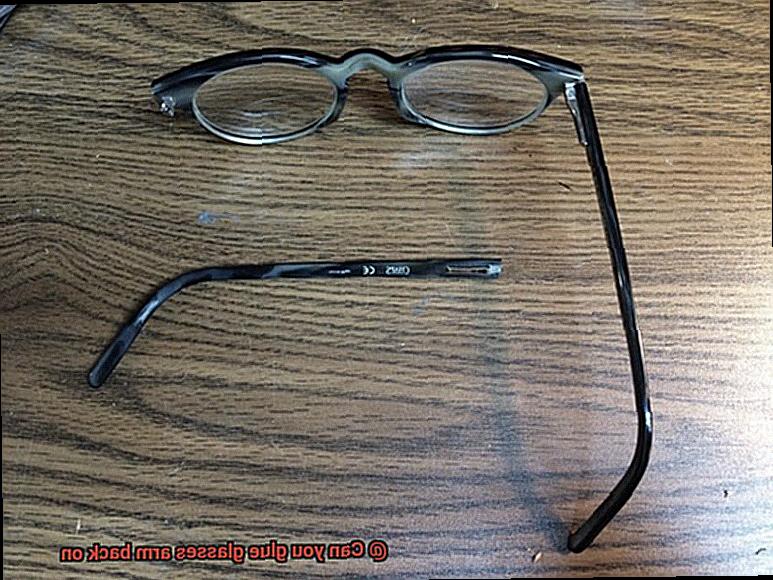
Check Your Prescription:
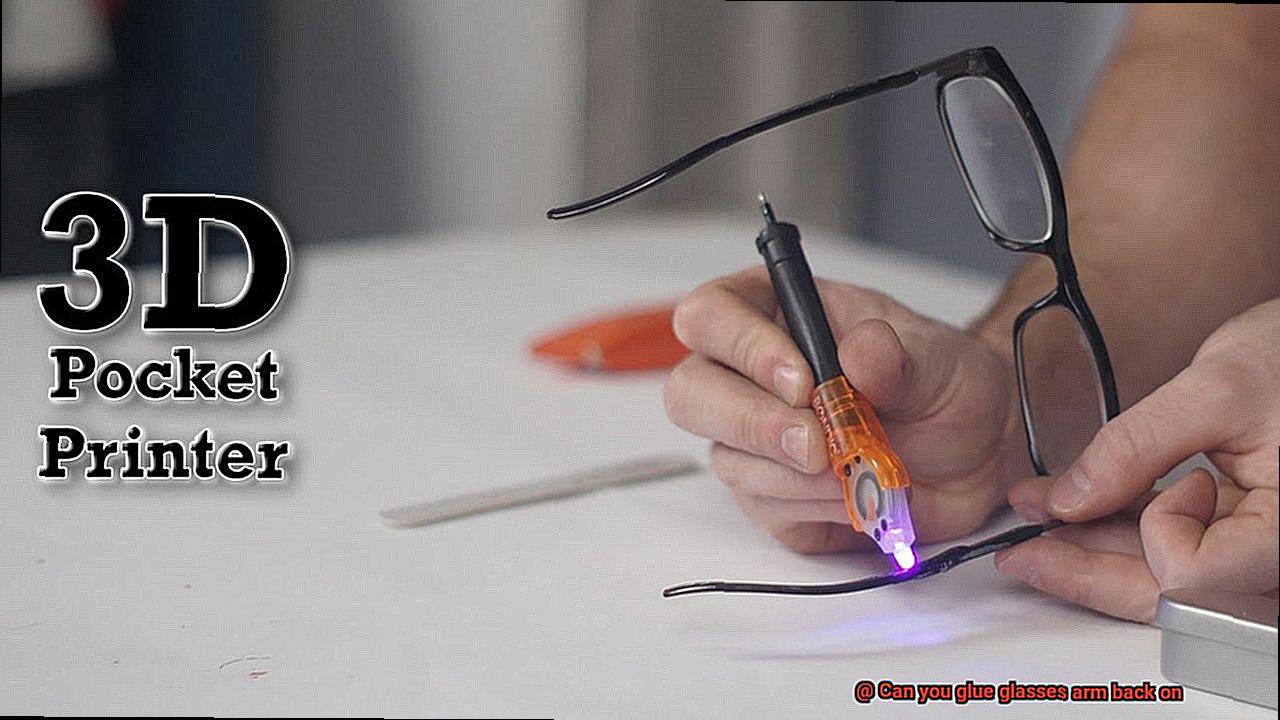
Extensive damage or recurring issues with glasses arms may indicate the need for a new prescription. Ill-fitting glasses or loose arms are signs that your current prescription might not be providing the correct level of vision correction. Consult with an optometrist or ophthalmologist to determine if a new prescription is necessary.
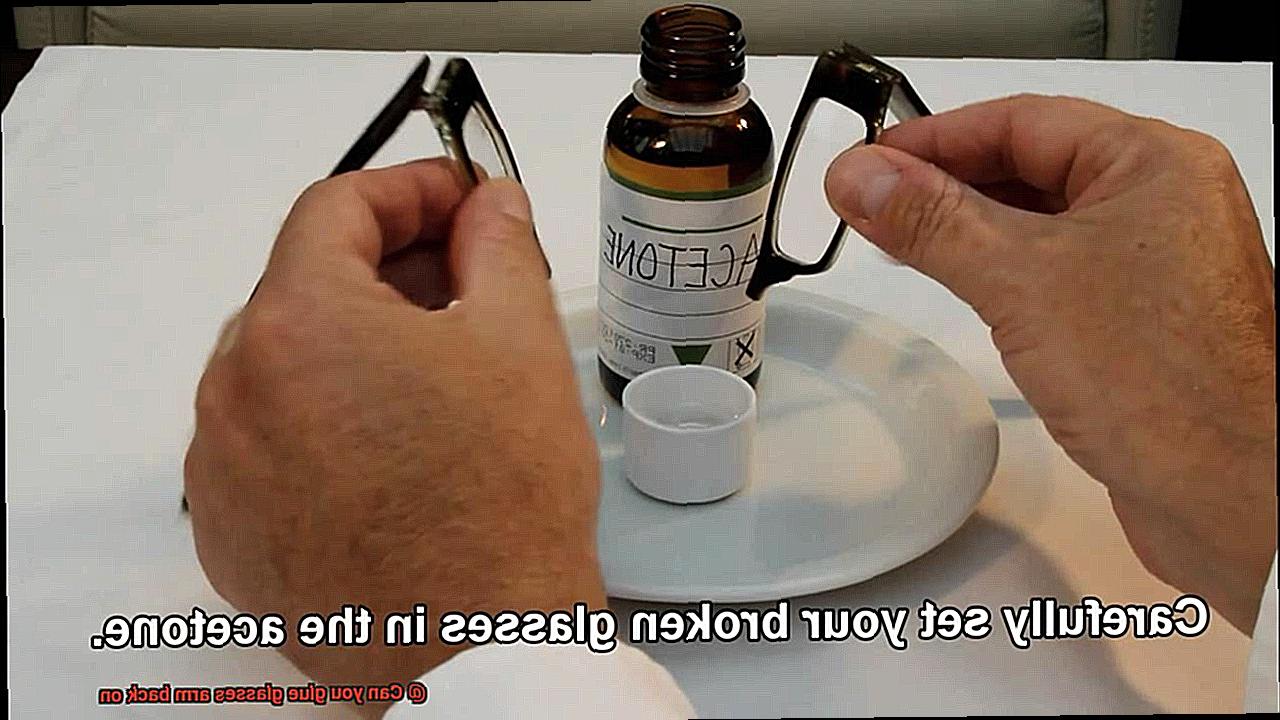
Common Mistakes to Avoid When Gluing Glasses Arms Back On
Common Mistakes to Avoid When Gluing Glasses Arms Back On
Intro:
We’ve all experienced that dreadful moment when a glasses arm snaps. But fear not. Before you reach for the glue, let’s discuss the common mistakes you need to avoid for a successful and long-lasting repair. Trust me, as an eyewear expert, I’ve seen it all.
Choose the Right Glue:
Don’t fall into the trap of using any old glue lying around in your house. Glasses frames are made of various materials like metal or plastic, so you need a specialized adhesive designed for bonding these specific materials. Regular glues may not provide sufficient strength or adhere properly, resulting in a weak repair.
Prepare the Surfaces:
Cleanliness is key. Before applying any glue, make sure to thoroughly clean the surfaces where the glasses arm and frame will be joined. Dirt, oils, or residue can hinder the bonding process and weaken the repair. Gently clean with a mild solution and a soft cloth for a clean and dry surface that promotes better adhesion.
Apply Glue in Moderation:
Remember, less is more when it comes to glue. Overapplying can cause excess to seep out, creating a messy appearance. It can also make it challenging to align the glasses arm properly, resulting in an uneven attachment. Apply a thin, even layer of glue along the contact area for a secure bond without any unsightly overflow.
Patience is Key:
Don’t rush the drying process. Glues require specific curing time to achieve maximum strength. Follow the manufacturer’s instructions regarding drying time and resist the temptation to use your glasses before the recommended period has elapsed. Rushing it can lead to a weak bond that easily breaks or separates.
Reinforce for Longevity:
Even with a successful glue job, glasses arms can still experience stress or strain, causing them to detach again over time. To prevent this, reinforce the repaired area with additional measures. Consider using clear nail polish or heat-shrink tubing around the joint for extra stability and durability. These reinforcements will fortify the repair, ensuring it withstands everyday wear and tear.
Pbf7VqGXKHo” >
Conclusion
Yes, it is possible to glue a glasses arm back on.
With a steady hand and the right adhesive, you can restore your favorite pair of spectacles to their former glory. Don’t let a broken arm be the end of your eyewear’s story.
Take matters into your own hands and bring those frames back to life. Just imagine the satisfaction of seeing them whole again, perched perfectly on your nose.
It may take some patience and precision, but with a little effort, you can make those glasses as good as new.

